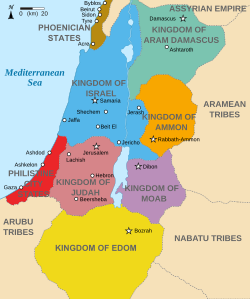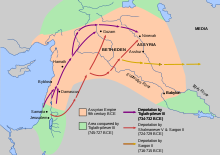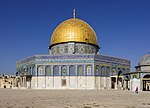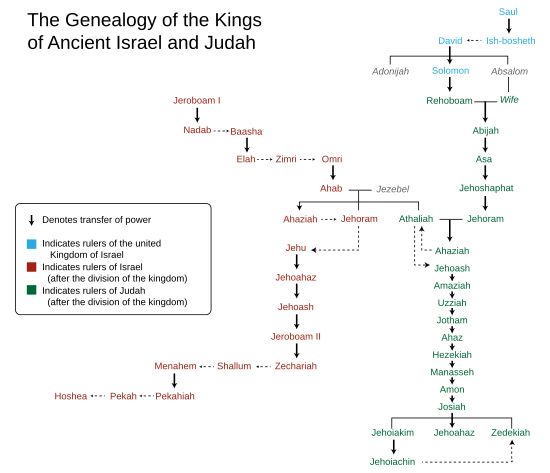Kingdom of Israel (Samaria)
This article needs additional citations for verification. (January 2022) |
Kingdom of Israel 𐤉𐤔𐤓𐤀𐤋[1] | |||||||
|---|---|---|---|---|---|---|---|
| c. 930 BCE–c. 720 BCE | |||||||
 Map of the southern Levant in the 9th century BCE, with Israel in blue | |||||||
| Status | Kingdom | ||||||
| Capital | |||||||
| Common languages | Biblical Hebrew, Israelian Hebrew | ||||||
| Religion | |||||||
| Government | Monarchy | ||||||
| King | |||||||
• 931-910 BCE | Jeroboam I (first) | ||||||
• 732–c. 720 BCE | Hoshea (last) | ||||||
| Historical era | Iron Age | ||||||
• Established | c. 930 BCE | ||||||
| c. 720 BCE | |||||||
| |||||||
| Today part of | |||||||
The Kingdom of Israel (Biblical Hebrew: מַמְלֶכֶת יִשְׂרָאֵל, romanized: Mamleḵeṯ Yīśrāʾēl), or the Kingdom of Samaria, was an Israelite kingdom in the Southern Levant during the Iron Age, whose beginnings can be dated back to the first half of the 10th century BCE.[2] The kingdom controlled the areas of Samaria, Galilee and parts of Transjordan. The regions of Samaria and Galilee underwent a period with large number of settlements during the 10th century BCE,[3] with the capital in Shechem, and then in Tirzah. The kingdom was ruled by the Omride dynasty in the 9th century BCE, whose political center was the city of Samaria.
The Hebrew Bible depicts the Kingdom of Israel, also known as the Kingdom of Samaria, as one of two successor states to the United Kingdom of Israel ruled by King David and his son Solomon, the other being the Kingdom of Judah to the south. Many historians and archaeologists, however, do not believe in the existence of a United Kingdom as depicted in the Bible.[Notes 1]
The Kingdom of Israel was conquered by the Neo-Assyrian Empire around 720 BCE.[4] The records of Sargon II of Assyria indicate that he deported 27,290 Israelites – around one fifth of the population of the Kingdom of Israel[5] – to Mesopotamia;[6] this deportation became the basis for the Jewish idea of the Ten Lost Tribes of Israel. Some Israelites migrated to the southern kingdom of Judah,[7] while those Israelites that remained in Samaria, concentrated mainly around Mount Gerizim, came to be known as Samaritans.[8][9] Foreign groups were also settled by the Assyrians in the territories of the conquered kingdom.[9]
History[edit]

According to Israel Finkelstein, Shoshenq I's campaign in the second half of the 10th century BCE collapsed the early polity of Gibeon in central highlands, and made possible the beginning of the Northern Kingdom, with its capital at Shechem,[10][11] around 931 BCE. Israel consolidated as a kingdom in the first half of 9th century BCE,[12] with its capital at Tirzah first,[13] and next at the city of Samaria since 880 BCE. The existence of this Israelite state in the north is documented in 9th century inscriptions.[14] The earliest mention is from the Kurkh stela of c.853 BCE, when Shalmaneser III mentions "Ahab the Israelite", plus the denominative for "land", and his ten thousand troops.[15] This kingdom would have included parts of the lowlands (the Shephelah), the Jezreel plain, lower Galilee and parts of the Transjordan.[15]
Ahab's forces were part of an anti-Assyrian coalition, implying that the kingdom was ruled by an urban elite, possessed a royal and state cult with large urban temples, and had scribes, mercenaries, and an administrative apparatus.[15] In all this, it was similar to other recently-founded kingdoms of the time, such as Ammon and Moab.[15] Samaria is one of the most universally accepted archaeological sites from the biblical period.[16] In around 840 BCE, the Mesha Stele records the victory, which happened years before, of the Kingdom of Moab (in today's Jordan), under King Mesha, over the Kingdom of Israel, under king Omri and his son Ahab.[17]
Archaeological finds, ancient Near Eastern texts, and the biblical record testify that in the time of the Omride dynasty, the Kingdom of Israel ruled in the mountainous Galilee, at Hazor in the upper Jordan Valley, in large parts of Transjordan between the Arnon and the Yarmouk Rivers, and in the coastal plain of the Sharon.[18]
In Assyrian inscriptions, the Kingdom of Israel is referred to as the "House of Omri".[15] Shalmanesser III's "Black Obelisk" mentions Jehu, son of Omri.[15] King of Assyria Adad-Nirari III did an expedition into the Levant around 803 BCE mentioned in the Nimrud slab, which comments he went to "the Hatti and Amurru lands, Tyre, Sidon, the mat of Hu-um-ri (land of Omri), Edom, Philistia and Aram (not Judah)."[15] Rimah Stele, from the same king introduces a third way of talking about the kingdom, as Samaria, in the phrase "Joash of Samaria".[19] The use of Omri's name to refer to the kingdom still survived, and was used by Sargon II in the phrase "the whole house of Omri" in describing his conquest of the city of Samaria in 722 BCE.[20] It is significant that the Assyrians never mention the Kingdom of Judah until the end of the 8th century, when it was an Assyrian vassal: possibly they never had contact with it, or possibly they regarded it as a vassal of Israel/Samaria or Aram, or possibly the southern kingdom did not exist during this period.[21]
In the Bible[edit]

One traditional source for the history of the Kingdom of Israel has been the Jewish Bible, written by authors in Jerusalem, the capital of the Kingdom of Judah; being written by a rival kingdom, it is inspired by ideological and theological viewpoints that influence the narrative.[18] Anachronisms, legends and literary forms also affect the story. Some of the events are believed to have been recorded long after the destruction of the kingdom of Israel. Biblical archaeology has both confirmed and challenged parts of the biblical account.[18] According to the Jewish Bible, there existed a United Kingdom of Israel (the United Monarchy), ruled from Jerusalem by David and his son Solomon, after whose death Israel and Judah separated into two kingdoms.
The first mention of the name Israel is from an Egyptian inscription, the Merneptah Stele, dating from the Late Bronze Age (c. 1208 BCE); this gives little solid information, but indicates that the name of the later kingdom was borrowed rather than originating with the kingdom itself.[22]
Relations between the kingdoms of Israel and Judah[edit]
According to the Hebrew Bible, for the first sixty years after the split, the kings of Judah tried to re-establish their authority over the northern kingdom, and there was perpetual war between them. For the following eighty years, there was no open war between them, as, for the most part, Judah had engaged in a military alliance with Aram-Damascus, opening a northern front against Israel.[23] The conflict between Israel and Judah was temporarily settled when Jehoshaphat, King of Judah, allied himself with the reigning house of Israel, Ahab, through marriage. Later, Jehosophat's son and successor, Jehoram of Judah, married Ahab's daughter Athaliah, cementing the alliance.[23] However, the sons of Ahab were slaughtered by Jehu following his coup d'état around 840 BCE.[24]
From Hazael to Jeroboam II[edit]
After being defeated by Hazael, Israel began a period of progressive recovery following the campaigns against Aram-Damascus of Adad-nirari III.[25] This ultimately led to a period of major territorial expansion under Jeroboam II, who extended the kingdom's possessions throughout the Northern Transjordan. Following Jeroboam II's death, the Kingdom experienced a period of decline as a result of sectional rivalries and struggles for the throne.[26]
Destruction of the Kingdom, 732–720 BCE[edit]

In c. 732 BCE, king Pekah of Israel, while allied with Rezin, king of Aram, threatened Jerusalem. Ahaz, king of Judah, appealed to Tiglath-Pileser III, the king of Assyria, for help. After Ahaz paid tribute to Tiglath-Pileser,[27] Tiglath-Pileser sacked Damascus and Israel, annexing Aram[28] and territory of the tribes of Reuben, Gad and Manasseh in Gilead including the desert outposts of Jetur, Naphish and Nodab. People from these tribes, including the Reubenite leader, were taken captive and resettled in the region of the Khabur River system, in Halah, Habor, Hara and Gozan (1 Chronicles 5:26). Tiglath-Pilesar also captured the territory of Naphtali and the city of Janoah in Ephraim, and an Assyrian governor was placed over the region of Naphtali. According to 2 Kings 16:9 and 2 Kings 15:29, the population of Aram and the annexed part of Israel was deported to Assyria.[29]

The remainder of the northern kingdom of Israel continued to exist within the reduced territory as an independent kingdom until around 720 BCE, when it was again invaded by Assyria and the rest of the population deported. During the three-year siege of Samaria in the territory of Ephraim by the Assyrians, Shalmaneser V died and was succeeded by Sargon II, who himself records the capture of that city thus: "Samaria I looked at, I captured; 27,280 men who dwelt in it I carried away" into Assyria. Thus, around 720 BCE, after two centuries, the kingdom of the ten tribes came to an end. Some of the Israelite captives were resettled in the Khabur region, and the rest in the land of the Medes, thus establishing Hebrew communities in Ecbatana and Rages. The Book of Tobit additionally records that Sargon had taken other captives from the northern kingdom to the Assyrian capital of Nineveh, in particular Tobit from the town of Thisbe in Naphtali.[citation needed]
The Jewish Bible relates that the population of the Kingdom of Israel was exiled, becoming known as the Ten Lost Tribes. To the south, the Tribe of Judah, the Tribe of Simeon (that was "absorbed" into Judah), the Tribe of Benjamin and the people of the Tribe of Levi, who lived among them of the original Israelite nation, remained in the southern Kingdom of Judah. The Kingdom of Judah continued to exist as an independent state until 586 BCE, when it was conquered by the Neo-Babylonian Empire.
Samaritan version[edit]
Samaritan tradition states that much of the population of the Northern Kingdom of Israel remained in place after the Exile, including the Tribes of Naphtali, Menasseh, Benjamin and Levi – being the progenitors of the modern Samaritans. In their book The Bible Unearthed, Israeli authors Israel Finkelstein and Neil Asher Silberman estimate that only a fifth (about 40,000) of the population of the northern Kingdom of Israel were actually resettled out of the area during the two deportation periods under Tiglath-Pileser III and Sargon II.[5]: 221 Many of the Northern Tribes also fled south to the Kingdom of Judah; Jerusalem seems to have expanded in size five-fold during this period, requiring a new wall to be built, and a new source of water Siloam to be provided by King Hezekiah.[7]
Recorded history[edit]

In their book The Bible Unearthed, Israeli authors Israel Finkelstein and Neil Asher Silberman estimate that only a fifth (about 40,000) of the population of the northern Kingdom of Israel were actually resettled out of the area during the two deportation periods under Tiglath-Pileser III and Sargon II.[5] No known non-Biblical record exists of the Assyrians having exiled people from four of the tribes of Israel: Dan, Asher, Issachar, Zebulun. Descriptions of the deportation of people from Reuben, Gad, Manasseh, Ephraim and Naphtali indicate that only a portion of these tribes were deported, and the places to which they were deported are known locations given in the accounts. The deported communities are mentioned as still existing at the time of the composition of the Books of Kings and Chronicles and did not disappear by assimilation. 2 Chronicles 30:1–18 explicitly mentions northern Israelites who had been spared by the Assyrians, in particular people of Ephraim, Manasseh, Asher, Issachar and Zebulun, and how members of the latter three returned to worship at the Temple in Jerusalem during the reign of Hezekiah.[33]

Religion[edit]
The religious climate of the Kingdom of Israel appears to have followed two major trends. The first was the worship of Yahweh; the religion of ancient Israel is sometimes referred to by modern scholars as Yahwism.[34] The Hebrew Bible, however, states that some of the northern Israelites also adored Baal (see 1 Kings 16:31 and the Baal cycle discovered at Ugarit).[34] The reference in Hosea 10 to Israel's "divided heart"[35] may refer to these two cultic observances, although alternatively it may refer to hesitation between looking to Assyria and Egypt for support.[36]
The Jewish Bible also states that Ahab allowed the cult worship of Baal to become acceptable of the kingdom. His wife Jezebel was the daughter of the Phoenician king of Tyre and a devotee to Baal worship (1 Kings 16:31).[37]
Royal houses[edit]
| History of Palestine |
|---|
 |
| History of Israel |
|---|
 |
| |
According to the Bible, the Northern Kingdom had 19 kings across 9 different dynasties throughout its 208 years of existence.

List of proposed Assyrian references to Kingdom of Israel (Samaria)[edit]
The table below lists all the historical references to the Kingdom of Israel (Samaria) in Assyrian records.[38] King Omri's name takes the Assyrian shape of "Humri", his kingdom or dynasty that of Bit Humri or alike—the "House of Humri/Omri".
| Assyrian King | Inscription | Year | Transliteration | Translation |
|---|---|---|---|---|
| Shalmaneser III | Kurkh Monoliths | 853 BCE | KUR sir-'i-la-a-a | "Israel" |
| Shalmaneser III | Black Obelisk, Calah Fragment, Kurba'il Stone, Ashur Stone | 841 BCE | mar Hu-um-ri-i | "of Omri" |
| Adad-nirari III | Tell al-Rimah Stela | 803 BCE | KUR Sa-me-ri-na-a-a | "land of Samaria" |
| Adad-nirari III | Nimrud Slab | 803 BCE | KUR <Bit>-Hu-um-ri-i | "the 'land of [the House of] Omri" |
| Tiglath-Pileser III | Layard 45b+ III R 9,1 | 740 BCE | [KUR sa-me-ri-i-na-a-a] | ["land of Samaria"] |
| Tiglath-Pileser III | Iran Stela | 739–738 BCE | KUR sa-m[e]-ri-i-na-a-[a] | "land of Samaria" |
| Tiglath-Pileser III | Layard 50a + 50b + 67a | 738–737 BCE | URU sa-me-ri-na-a-a | "city of Samaria" |
| Tiglath-Pileser III | Layard 66 | 732–731 BCE | URU Sa-me-ri-na | "city of Samaria" |
| Tiglath-Pileser III | III R 10,2 | 731 BCE | KUR E Hu-um-ri-a | "land of the House of Omri" |
| Tiglath-Pileser III | ND 4301 + 4305 | 730 BCE | KUR E Hu-um-ri-a | "land of the House of Omri" |
| Shalmaneser V | Babylonian Chronicle ABC1 | 725 BCE | URU Sa-ma/ba-ra-'-in | "city of Samaria" |
| Sargon II | Nimrud Prism, Great Summary Inscription | 720 BCE | URU Sa-me-ri-na | "city of Samaria" |
| Sargon II | Palace Door, Small Summary Inscription, Cylinder Inscription, Bull Inscription | 720 BCE | KUR Bit-Hu-um-ri-a | "land of Omri" |
References[edit]
Notes[edit]
- ^ The debate is described in Amihai Mazar (2010), "Archaeology and the Biblical Narrative: The Case of the United Monarchy", pp. 29-30, fn. 2: "For conservative approaches defining the United Monarchy as a state 'from Dan to Beer Sheba' including 'conquered kingdoms' (Ammon, Moab, Edom) and 'spheres of influence' in Geshur and Hamath cf. e.g. Ahlström (1993), 455–542; Meyers (1998); Lemaire (1999); Masters (2001); Stager (2003); Rainey (2006), 159–168; Kitchen (1997); Millard (1997; 2008). For a total denial of the historicity of the United Monarchy cf. e.g. Davies (1992), 67–68; others suggested a 'chiefdom' comprising a small region around Jerusalem, cf. Knauf (1997), 81–85; Niemann (1997), 252–299 and Finkelstein (1999). For a 'middle of the road' approach suggesting a United Monarchy of larger territorial scope though smaller than the biblical description cf. e.g. Miller (1997); Halpern (2001), 229–262; Liverani (2005), 92–101. The latter recently suggested a state comprising the territories of Judah and Ephraim during the time of David, that was subsequently enlarged to include areas of northern Samaria and influence areas in the Galilee and Transjordan. Na'aman (1992; 1996) once accepted the basic biography of David as authentic and later rejected the United Monarchy as a state, cf. id. (2007), 401–402."
Citations[edit]
- ^
- Rollston, Chris A. (2010). Writing and Literacy in the World of Ancient Israel: Epigraphic Evidence from the Iron Age. Society of Biblical Literature. pp. 52–54. ISBN 978-1-58983-107-0.
- Compston, Herbert F. B. (1919). The Inscription on the Stele of Méšaʿ.
- ^ Arie, Eran (2023). "Canaanites in a Changing World: The Jezreel Valley during the Iron Age I". In Koch, Ido; Lipschits, Oded; Sergi, Omer (eds.). From Nomadism to Monarchy?: Revisiting the Early Iron Age Southern Levant. Penn State Press. p. 120. ISBN 978-1-64602-270-0.
[T]he growing proto-Israelite power in the central hill country, out of which would emerge the Northern Kingdom of Israel, [that] should be dated to the first half of the 10th century BCE.
- ^ Killebrew, Ann E., (2014). "Israel during the Iron Age II Period", in: The Archaeology of the Levant, Oxford University Press, p. 733: "In the Lower Galilee [...] during the Iron IIA, earlier Iron I settlements were deserted and appear to have been replaced by new large fortified sites [and] Zertal's landmark survey of northern Samaria [...] demonstrates a doubling of the number of sites from the Iron I to II [...] Finkelstein and Lederman's survey of the territory of Ephraim revealed [the] settlement density peaks in the later Iron II period, with over 200 sites identified [...]"
- ^ Hasegawa, Levin & Radner 2018, p. 55.
- ^ a b c Finkelstein, Israel; Silberman, Neil Asher (2002) The Bible Unearthed : Archaeology's New Vision of Ancient Israel and the Origin of Its Sacred Texts, Simon & Schuster, ISBN 978-0-684-86912-4
- ^ Younger, K. Lawson (1998). "The Deportations of the Israelites". Journal of Biblical Literature. 117 (2): 201–227. doi:10.2307/3266980. ISSN 0021-9231. JSTOR 3266980.
- ^ a b Finkelstein, Israel (28 June 2015). "Migration of Israelites into Judah after 720 BCE: An Answer and an Update". Zeitschrift für die alttestamentliche Wissenschaft. 127 (2): 188–206. doi:10.1515/zaw-2015-0011. ISSN 1613-0103. S2CID 171178702.
- ^ Shen et al. 2004.
- ^ a b Finkelstein, Israel (2013). The forgotten kingdom : the archaeology and history of Northern Israel. Society of Biblical Literature. p. 158. ISBN 978-1-58983-910-6. OCLC 949151323.
- ^ Finkelstein, Israel, (2022). "The Impact of the Sheshonq I Campaign on the Territorial History of the Levant: An Update", "[...] Sheshoq I campaign [...] brought the collapse of [...] an early Israelite polity in the central highlands and neighboring areas [and replaced it by] the Northern Kingdom in the Samaria highlands and the Jezreel Valley" (Abstract).
- ^ Finkelstein, Israel, (2022): "...In the central part of the country, [Shoshenq I's campaign] caused the decline of an early Israelite entity [Gibeon polity], probably the one memorized in the Bible as the House of Saul, and the rise of the Northern Kingdom, which was centered around Shechem and expanded, under pharaonic auspices, to the Jezreel--Beth-shean Valley..." (Summary).
- ^ Finkelstein, Israel, (2020). "Saul and Highlands of Benjamin Update: The Role of Jerusalem", in Joachim J. Krause, Omer Sergi, and Kristin Weingart (eds.), Saul, Benjamin, and the Emergence of Monarchy in Israel: Biblical and Archaeological Perspectives, SBL Press, Atlanta, GA, p. 48, footnote 57: "...They became territorial kingdoms later, Israel in the first half of the ninth century BCE and Judah in its second half..."
- ^ Sergi 2023, p. 77, "...almost one hundred years from the destruction of Shechem ...a new urban center emerged in the region, first and only for a short time at Tell el-Far'ah (North), identified as the biblical Tirzah (Albright 1925)..."
- ^ Dever 2017, p. 338.
- ^ a b c d e f g Davies 2015, p. 72.
- ^ See Yohanan Aharoni, et al. (1993) The Macmillan Bible Atlas, p. 94, Macmillan Publishing: New York; and Amihai Mazar (1992) The Archaeology of the Land of the Bible: 10,000 – 586 B.C.E, p. 404, New York: Doubleday, see pp. 406-410 for discussion of archaeological significance of Shomron (Samaria) under Omride Dynasty.
- ^ 2 Kings 3
- ^ a b c Finkelstein, Israel (2013). The forgotten kingdom: the archaeology and history of Northern Israel. p. 74. ISBN 978-1-58983-910-6. OCLC 949151323.
- ^ Davies 2015, p. 72-73.
- ^ Davies 2015, p. 73.
- ^ Davies 2015, p. 3.
- ^ Davies 2015, p. 71-72.
- ^ a b Roberts 2016, p. 203.
- ^ Roberts 2016, p. 204.
- ^ Roberts 2016, p. 206.
- ^ Roberts 2016, p. 207.
- ^ 2 Kings 16:7–9
- ^ Lester L. Grabbe (2007). Ancient Israel: What Do We Know and How Do We Know It?. New York: T&T Clark. p. 134. ISBN 978-05-67-11012-1.
- ^ 2 Kings 16:9 and 15:29
- ^ Kuan, Jeffrey Kah-Jin (2016). Neo-Assyrian Historical Inscriptions and Syria-Palestine: Israelite/Judean-Tyrian-Damascene Political and Commercial Relations in the Ninth-Eighth Centuries BCE. Wipf and Stock Publishers. pp. 64–66. ISBN 978-1-4982-8143-0.
- ^ Cohen, Ada; Kangas, Steven E. (2010). Assyrian Reliefs from the Palace of Ashurnasirpal II: A Cultural Biography. UPNE. p. 127. ISBN 978-1-58465-817-7.
- ^ Delitzsch, Friedrich; McCormack, Joseph; Carruth, William Herbert; Robinson, Lydia Gillingham (1906). Babel and Bible;. Chicago, The Open court publishing company. p. 78.
- ^ 2 Chronicles 30:1–18
- ^ a b Miller, Patrick D. (2000). The religion of ancient Israel. London: SPCK. ISBN 978-0-664-22145-4. OCLC 44174114.
- ^ Hosea 10:2 in the New Revised Standard Version, but some translators prefer "deceitful", as in the New International Version.
- ^ Jerusalem Bible (1966), Footnote b at Hosea 10:2
- ^
 This article incorporates text from a publication now in the public domain: Hirsch, Emil G.; Price, Ira Maurice (1901–1906). "JEZEBEL". In Singer, Isidore; et al. (eds.). The Jewish Encyclopedia. New York: Funk & Wagnalls.
This article incorporates text from a publication now in the public domain: Hirsch, Emil G.; Price, Ira Maurice (1901–1906). "JEZEBEL". In Singer, Isidore; et al. (eds.). The Jewish Encyclopedia. New York: Funk & Wagnalls. - ^ Kelle, Brad, (2002). "What's in a Name? Neo-Assyrian Designations for the Northern Kingdom and Their Implications for Israelite History and Biblical Interpretation", Journal of Biblical Literature, 121 (4), pp. 639–666, (See table in p. 640).
Sources[edit]
- Davies, Philip (2015). The History of Ancient Israel. Bloomsbury Publishing. ISBN 978-0-567-65582-0.
- Dever, William (2017). Beyond the Texts: An Archaeological Portrait of Ancient Israel and Judah. SBL Press. ISBN 978-0-88414-217-1.
- Hasegawa, Shuichi; Levin, Christoph; Radner, Karen, eds. (2018). The Last Days of the Kingdom of Israel. Walter de Gruyter GmbH & Co KG. ISBN 978-3-11-056660-4.
- Mazar, Amihai (2010). "Archaeology and the Biblical Narrative: The Case of the United Monarchy". In Kratz, Reinhard G.; Spieckermann, Hermann (eds.). One God – One Cult – One Nation: Archaeological and Biblical Perspectives. Walter de Gruyter. ISBN 978-3-11-022358-3.
- Roberts, J. J. M. (2016). "The Divided Monarchy". In Niditch, Susan (ed.). The Wiley Blackwell Companion to Ancient Israel. John Wiley & Sons. pp. 197–212. ISBN 978-0-470-65677-8.
- Sergi, Omer (2023). The Two Houses of Israel: State Formation and the Origins of Pan-Israelite Identity. SBL Press. ISBN 978-1-62837-345-5.
- Shen, Peidong; Lavi, Tal; Kivisild, Toomas; Chou, Vivian; Sengun, Deniz; Gefel, Dov; Shpirer, Issac; Woolf, Eilon; Hillel, Jossi; Feldman, Marcus W.; Oefner, Peter J. (2004). "Reconstruction of patrilineages and matrilineages of Samaritans and other Israeli populations from Y-Chromosome and mitochondrial DNA sequence Variation". Human Mutation. 24 (3): 248–260. doi:10.1002/humu.20077. ISSN 1059-7794. PMID 15300852. S2CID 1571356.
External links[edit]
- About Israel - The Information Center About Israel
- The Jewish History Resource Center Project of the Dinur Center for Research in Jewish History, The Hebrew University of Jerusalem
- Complete Bible Genealogy A synchronized chart of the kings of Israel and Judah


 French
French Deutsch
Deutsch